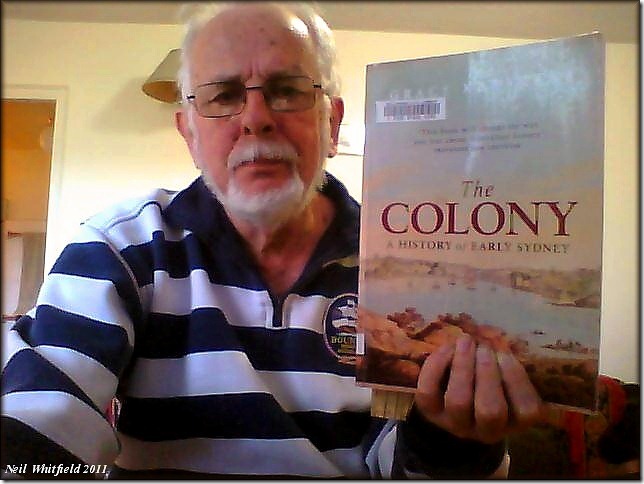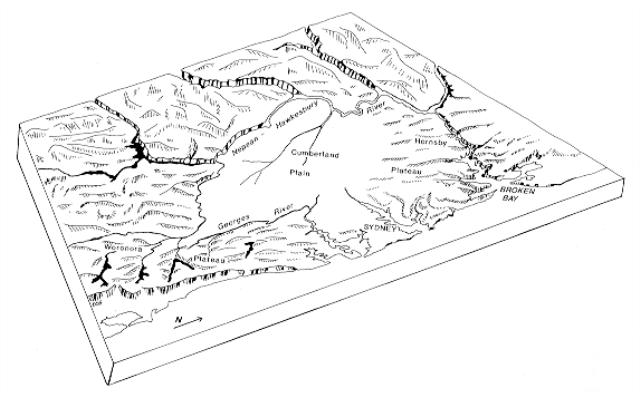
It deservedly won the PM’s Prize in 2010. “Grace Karskens’ The Colony: A History of Early Sydney (Allen & Unwin, 2009) has won the Prime Minister’s Literary Award for nonfiction. The Colony provides a rich new interpretation of the early life of Sydney. Supported by a fertile diversity of sources, it is a rich history of a dynamic colony and a rounded account of the lives of the people who lived there.” I have been savouring it from February – it went to hospital with me — until right now, thanks to Wollongong Library’s generous loan periods.
The first great thing to note is that it does not see early Sydney as consisting merely of Macquarie Street and Circular Quay with a few afterthoughts – and Parramatta of course. This ranges the Cumberland Plain, as it should, because I find on reflecting on my own family history that seems to be how they experienced the colony. My family arrived just at the end of the period this book chronicles – 1822.
Second is that stereotypes and half-truths come tumbling down right and left as you read on, but all done in the most polite and professional manner – and done most convincingly. Thus we learn there probably was no orgy during the thunder storm soon after the First Fleet arrived. This is first heard of in Manning Clark’s Short History of Australia in 1963 and has been embellished ever since. It makes an appearance in Ashley Hay’s brilliant new novel The Body in the Clouds (2010) – more on that in another entry. The lurid version of our past popularised so successfully in Robert Hughes The Fatal Shore (1987) is left resembling historical fantasy rather than sober reality. The reality turns out to be far more believable and far more interesting.
Karskens also restores the First Australians to their rightful place in the story, but this is no tub-thump on the lines of Pilger’s Secret Country. Again the reality proves more interesting and far more complex. I was fascinated to learn that the body of a victim of the 18th century smallpox catastrophe was found in recent years in Gymea in Sutherland Shire. That whole event, as so much else in this book, is handled judiciously and brilliantly.
I was pleased to see my nephew gets a mention too in the discussion of Bungaree.
It turns out the fate of the Cumberland Plain Aboriginal groups is much more complex than we may have believed in the past. That much survived is a fact not acknowledge so often in the past.
Another book which shows continuities which the old people – two generations or more before me – knew about but shut up about is Rivers and Resilience: Aboriginal People on Sydney’s Georges River by Heather Goodall and Alison Cadzow (UNSW 2009). What is revealed there again resonates with so much else half-remembered about my own family.
It was fascinating too to have shared my hospital time with a direct descendant of James Ruse, “Australia’s first farmer”. What I could glean in the short time I spent with Rocky – the descendant – revealed yet again the complex web of interactions between colonists and colonised over the past 200+ years.
Further reading
Holistic history of early Sydney
The Colony: A History Of Early Sydney
‘The Colony’ by Grace Karskens
…Karskens nails her colours to the mast: she is writing as an historian, and participating in a historical conversation with other historians:
This book has its roots deep in a great mountain of existing research, thinking and histories. Historians work collectively, within a wider community of scholars. So history writing is less an individualist pursuit than a collective quest, and an ongoing process. This is one reason references are so important: they rightly acknowledge the work of past scholars, as well as guiding future readers and scholars into the literature. In the notes and bibliography of this book you will find, besides original manuscripts and archival records, maps and pictures, an extraordinary and diverse body of scholarship about early Sydney, works mainly by historians, but also archaeologists, economists, anthropologists, art and architectual historians, ecologists, geologists, museuologists, geographers, biographers and local and community historians. (p. xii)
She is true to her word. There’s a heavy debt to Inga Clendinnen here, not only in content but in writing style, and likewise to Alan Atkinson– two historians I deeply admire whose writing turns an event around and looks at it from different angles, giving us the gift of coming to the familiar with new eyes. There’s also a connection with James Boyce whose recent book Van Diemen’s Land is almost a pigeon-pair with this book in its re-visioning of the penal colony as a new environment with new opportunities. Unlike Robert Hughes’ The Fatal Shore, this book joins other histories- John Hirst’s work springs to mind- written with a determination to look beyond Hughes’ gulag and horror: it looks to the agency, optimismism and opportunism of ordinary people in a new environment instead of just the dregs of the old world.
The history itself is a thing of beauty too. It breaks free of many straitjackets: more than perhaps any other history of Australia that I have read it interweaves Aboriginal history, archaeology, women and environmental history throughout the book. Not content with the almost obligatory “before” chapter dealing and then dispensing with “the aborigines”, she asserts that Sydney remained an Eora town- that Eora people continued to live within Sydney on their own terms, with their own geography and in resistance to christianizing impulses, into the 1830s and 40s. Indeed, they have never left…
To watch
Dr Grace Karskens: The heritage of Aboriginal Sydney: Placing lost histories

Thank you for this review. As a professional historian now taking on Australian history I am striving to learn all I can. I also noticed your shirt and must say I am a bit jealous…the Bounty story is one of my favorites in all of history!